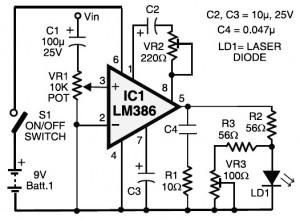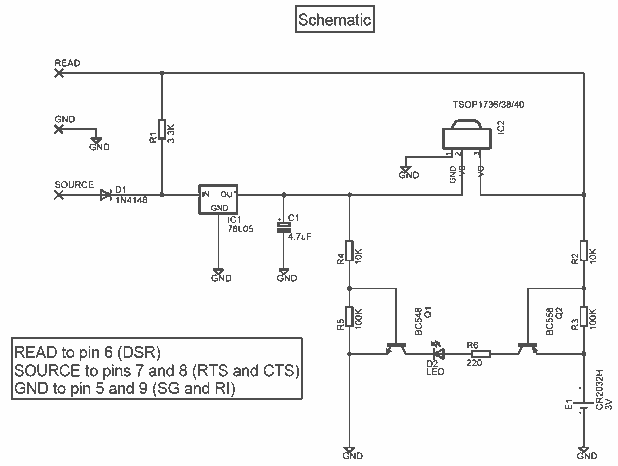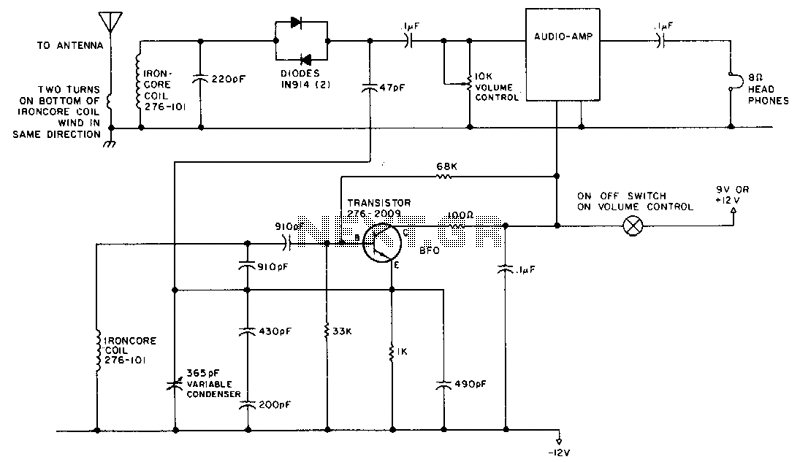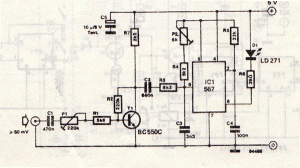
infrared ir receiver
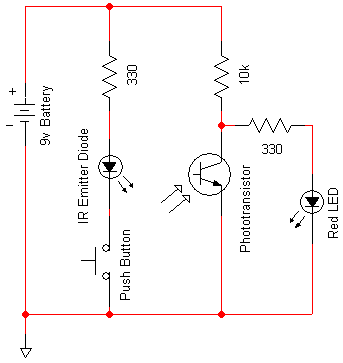
The operation of this receiver is analogous to human perception. Humans perceive colors and respond based on what they observe. Similarly, phototransistors react to the intensity of infrared light directed at them. The key distinction is that humans possess a brain to interpret various wavelengths of color, while infrared LEDs and phototransistors require additional circuitry to process transmitted data. To illustrate how information in the form of binary code (0s and 1s) can be transmitted using an IR emitter and phototransistor pair, a simple circuit can be constructed. The circuit operates as follows: a 9V battery powers both the IR emitter and the phototransistor. The IR emitter is activated only when a push button is pressed. When the emitter is off, the phototransistor does not conduct current, allowing current to flow through a red LED, keeping it illuminated. Upon pressing the push button, the emitter activates, directing infrared light at the phototransistor, which causes the red LED to turn off. This demonstration visually represents how digital signals can be transmitted wirelessly with these infrared components, where the illuminated red LED indicates a digital '1' and its absence indicates a digital '0'.
The described circuit consists of a 9V battery, an infrared (IR) emitter, a phototransistor, a push button switch, and a red LED. The circuit is designed to demonstrate the principles of infrared communication through binary signaling.
The 9V battery serves as the power source for the entire circuit. The IR emitter, typically an LED that emits infrared light, is connected in series with the push button switch. The push button acts as a control mechanism, allowing the user to activate the IR emitter. When the push button is not pressed, the circuit is open, and the phototransistor remains inactive. As a result, the current flows through the red LED, keeping it illuminated, which indicates a digital '1'.
Once the push button is pressed, the circuit closes, allowing current to flow to the IR emitter. The emitter then produces infrared light, which is detected by the phototransistor. When the phototransistor receives this infrared light, it transitions to its conductive state, diverting the current away from the red LED, which subsequently turns off. This state represents a digital '0'.
This simple yet effective circuit provides a clear visualization of how binary data is transmitted wirelessly using infrared technology. The transition between the red LED being on and off serves as a practical demonstration of the fundamental principles of digital communication, showcasing the role of the IR emitter and phototransistor in interpreting and transmitting binary signals.The way that this receiver works is very similar to the way that we as humans beings work. We see colors and we act depending on the different things seen. The phototransistors does the same thing, if reacts depending upon the intensity of infrared light being shined at it. The real difference between the two parallels seen above is that we humans already have a brain to interpret the different wave lenghts of color, where the infrared LED and phototransistor need some `intelligent` circuitry in order to know what to do when certain data is transmitted. If you`re still a little lost as to how information in the form of 0`s and 1`s can be transmitted using the IR emitter and phototransistor pair, here`s a quick circuit you can build that make make things more clear: Here`s how the circuit above works: The 9v battery is hooked up to both the IR Emitter and Phototransistor.
The IR Emitter, however, is never turned on unless you press the push button. Since the emitter is not powered on, the phototransistor won`t allow current to flow through it, so current will instead flow through the red LED. This means until you press the push button, the red LED remains on. After you press the push button, the emitter shines brightly at the phototransistor and the red LED turns off.
Here`s a video of this circuit in action: This should give you a much better visual of how digital 0`s and 1`s can be transmitted wirelessly using these two infrared components. When the red LED shines, you can see a digital 1. When we press the push button and the red LED turns off, that would be a 0. 🔗 External reference
The described circuit consists of a 9V battery, an infrared (IR) emitter, a phototransistor, a push button switch, and a red LED. The circuit is designed to demonstrate the principles of infrared communication through binary signaling.
The 9V battery serves as the power source for the entire circuit. The IR emitter, typically an LED that emits infrared light, is connected in series with the push button switch. The push button acts as a control mechanism, allowing the user to activate the IR emitter. When the push button is not pressed, the circuit is open, and the phototransistor remains inactive. As a result, the current flows through the red LED, keeping it illuminated, which indicates a digital '1'.
Once the push button is pressed, the circuit closes, allowing current to flow to the IR emitter. The emitter then produces infrared light, which is detected by the phototransistor. When the phototransistor receives this infrared light, it transitions to its conductive state, diverting the current away from the red LED, which subsequently turns off. This state represents a digital '0'.
This simple yet effective circuit provides a clear visualization of how binary data is transmitted wirelessly using infrared technology. The transition between the red LED being on and off serves as a practical demonstration of the fundamental principles of digital communication, showcasing the role of the IR emitter and phototransistor in interpreting and transmitting binary signals.The way that this receiver works is very similar to the way that we as humans beings work. We see colors and we act depending on the different things seen. The phototransistors does the same thing, if reacts depending upon the intensity of infrared light being shined at it. The real difference between the two parallels seen above is that we humans already have a brain to interpret the different wave lenghts of color, where the infrared LED and phototransistor need some `intelligent` circuitry in order to know what to do when certain data is transmitted. If you`re still a little lost as to how information in the form of 0`s and 1`s can be transmitted using the IR emitter and phototransistor pair, here`s a quick circuit you can build that make make things more clear: Here`s how the circuit above works: The 9v battery is hooked up to both the IR Emitter and Phototransistor.
The IR Emitter, however, is never turned on unless you press the push button. Since the emitter is not powered on, the phototransistor won`t allow current to flow through it, so current will instead flow through the red LED. This means until you press the push button, the red LED remains on. After you press the push button, the emitter shines brightly at the phototransistor and the red LED turns off.
Here`s a video of this circuit in action: This should give you a much better visual of how digital 0`s and 1`s can be transmitted wirelessly using these two infrared components. When the red LED shines, you can see a digital 1. When we press the push button and the red LED turns off, that would be a 0. 🔗 External reference
